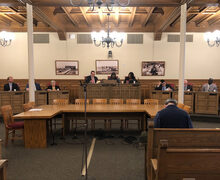School of Education professors awarded grant to examine teacher education simulations
Chase Guttman | Staff Photographer
Professors from the School of Education received a grant to examine teacher simulations, which are meant to be unscripted and seem real so students get practice in potentially-unnerving situations
UPDATED: Oct. 16 at 9:30 p.m.
Two professors in Syracuse University’s School of Education were awarded a $299,697 three-year grant by the National Science Foundation.
Ben Dotger, professor of teaching and leadership, and Sharon Dotger, associate professor of science education, will use the grant to examine simulations in future elementary teacher education.
Simulated Interaction Models is a teaching tool used in medical education since 1963. Nine years ago Ben began introducing them into the realm of teacher education. They’re now used with students in the School of Education at all levels through a partnership with State University of New York Upstate Medical University as a supplement to student-teaching placements in local schools and methods classes on campus.
“I wanted to try teach education a little differently,” Ben said. “It was important for me to try to take a stab at the gap between teacher preparation here on a college campus and teacher practice in a K-12 classroom.”
In simulations, the future teachers interact with students, parents and colleagues. The simulations are meant to be unscripted and seem real so students get practice in potentially-unnerving situations. After a student has completed their Simulated Interaction Model, they are able to play back video of themselves and reflect on what they did.
“Just like athletes watch themselves shooting free throws, they can see what they’re doing and then refine their thinking and how they engage with the ideas,” said Joanna Masingila, dean of the School of Education.
Denise Romero, a sophomore English education major, said she likes the fact that she is getting actual experience — even if it is an act. However, she is disappointed that there aren’t many simulations to partake in.
To date, 22 faculty members in the School of Education have designed, had their students engage in and/or analyze data from simulations — resulting in the largest research program in the School of Education.
Some of the simulations currently in use for math education involve the teacher candidate needing to explain to a student why a negative times a negative equals a positive, or why they can’t divide by zero. Simulations stress to prospective teachers that they need to be able to explain the ideas they’re going to be teaching, because “that’s just the way it is” isn’t an acceptable answer when there are proven explanations for phenomena, Masingila said.
“(Students) need to be able to talk and write about their ideas in classrooms where discussion is supported and wonder is inspired,” Sharon said.
Ben and Sharon have been developing the science-focused simulations since early July, and are working with content such as evolution, energy transfer and earth science. The curriculum is aligned with the Next Generation Science Standards.
Science often is overlooked in the elementary school system, as literacy and mathematic ability are concentration of standardized testing and thus dominate the K-5 daily schedule, Ben said. When students move on to middle and high school, science is often more difficult because they are lacking the background.
According to the 2012 National Survey of Science and Mathematics Education, only 39 percent of elementary teachers feel prepared to teach science — the lowest percentage for any of the four major content areas. The professors are hoping to increase the degree of confidence future teachers have in their ability to teach elementary science.
“In this area, Syracuse is really a leader. What we’re doing here has been really groundbreaking,” Masingila said.
The simulations have been implemented most comprehensively here, and other schools such as Vanderbilt University and University of Michigan are beginning to employ them as well.
“We hope it’s a piece of the puzzle that begins to serve as a very clear model for how we can begin approximating some of the instructional situations that we need our young teachers to have experience in,” Ben said. “Six simulations won’t ever encompass all the science that they ever need to teach, but if we can design a thoughtful model, then we can follow that later with other simulations and practical.”
CORRECTION: In a previous version of this article, the size of the research program in the School of Education was misattributed. The Daily Orange regrets this error.
Published on October 11, 2016 at 11:45 pm





